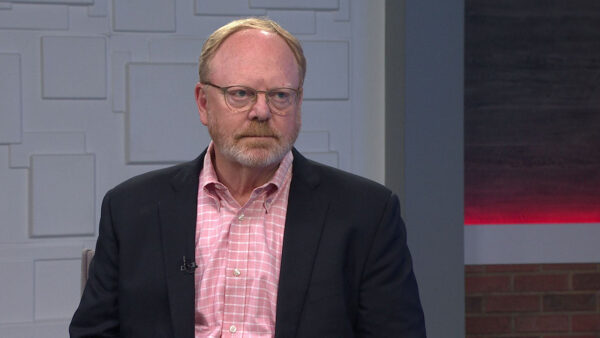Most of the nation will be switching to Daylight Savings Time Sunday. However, most of Arizona will not make the switch. Arizona State University climatologist Randy Cerveny will talk about why Arizona does not switch
Ted Simons: Most of the nation will be changing clocks and watches to daylight savings time this Sunday, but most of Arizona will not make the switch. Arizona State University climatologist Randy Cerveny is here to talk about why Arizona does not fall back or spring forward. Good to see you again.
Randy Cerveny: Good to be here.
Ted Simons: Let's talk -- Give us -- Define some parameters. What is daylight savings time?
Randy Cerveny: Well, it's a concept that dates back all the way to Benjamin Franklin. It's the idea that by switching or clocks we can have more sunlight in the evening hours in the summertime so that we could do things like harvest, and we could play baseball games in the evening hours, that we wouldn't be able to do if the clocks weren't adjusted.
Ted Simons: And we wouldn't have to use lights for most of the country, thus electricity, once electricity was discovered. That was an energy saver.
Randy Cerveny: Right. That's why daylight savings was originally known as wartime. It was put forth in World War I as a way to save energy during the war. And it was reinstituted back in World War II as a way to save energy.
Ted Simons: So World War I is in place, after that it stops. World War II it's in place, then it stops. Were folks getting tired of the back and forth?
Randy Cerveny: Arizona never liked it. We got off it as soon as we possibly could but then it was mandated in the 1960s when the whole country would go on a single time standard. We tried it for a year and said no, we don't want it.
Ted Simons: And for obvious reasons. This is the one place where really in the summertime you don't need more daylight especially late in the day.
Randy Cerveny: Our high temperatures usually occur around 3-4 o'clock in the afternoon. If you go on daylight savings time those degrees would be at 4 and 5 o'clock in the evening and we would have hotter temperatures into the evening hours and we simply didn't want that.
Ted Simons: Now, in Arizona, Navajo reservation, no daylight -- Daylight or no? What are they doing?
Randy Cerveny: The Navajo reservation goes on daylight savings time. So they'll be coming off of it this weekend. The reason for that is because they span more than just Arizona. They also have Window Rock, New Mexico. So they want to be all on the same time. They didn't want Window Rock to be two hours different from the rest of the reservation. So they go on daylight savings time. The Hopi reservation, entirely in Arizona, is surrounded by the Navajo reservation, doesn't go to daylight savings time. So there are a number of pockets.
Ted Simons: You could go back and forth in time as you travel across the state.
Randy Cerveny: Some travelers when they go up to the Hopi reservation expect an open gas station, might find it's already closed or vice versa.
Ted Simons: Any other states? I thought Indiana for a while didn't follow daylight savings time.
Randy Cerveny: Until about 2006, there's a time zone that cuts through the middle of Indiana and they wanted to try to keep on the same time. So they -- up until 2006 said we're not going to do that, but now they do. So the whole state does go on daylight savings time. Really, the only other state other than Arizona that doesn't go on daylight savings time is Hawaii.
Ted Simons: I guess they're so close to the equator, it doesn't make that much difference.
Randy Cerveny: They're so -- Again, it's very important in terms of commerce that when you're flying from one place to another, you want to keep the clocks in a consistent manner.
Ted Simons: So you don't hear much controversy regarding daylight savings time anymore. Is it going to stay this way for a while do you think? Is something going to happen in the future where things will change? What are you seeing?
Randy Cerveny: There are a lot of companies that would absolutely love to have us go on daylight savings time. You had the person on from Sky Harbor, the airline industry would actually love us to go on daylight savings time, because they have to adjust all their schedules and take into account that we don't go on. So companies that do interstate commerce would like us to go on daylight savings time.
Ted Simons: In terms of energy consumption, to have us with another hour of daylight would be murder.
Randy Cerveny: Yeah. That's not a big concern here. It's just simply -- It would actually probably add to our bill because with the extra air conditioning in the evening hours.
Ted Simons: All right. So we'll look forward to that Sunday as we become part of the Rocky Mountain west instead of the West Coast, which is an interesting psychological thing. Real quickly, recently we have had dust storms, and not monsoon haboob kind of dust storms. Just blankets of dust, seems like the Picacho peak is a magnet for it. What's going on?
Randy Cerveny: That is a very deadly stretch, and the reason why, this was not our typical Arizona monsoon thunderstorms that we had this last week that caused the big accident. This was a cold front that came through. But the winds are right around Picacho and the mountains on the east side, they get funneled right through that road. And when you funnel in the winds, the winds can increase in speed. While the winds outside that little gap area were less than 35 miles an hour, nothing the weather service was concerned about, when they funnel in that area they picked up speeds to 50 or 60 miles an hour.
Ted Simons: Are these winds of a certain direction? Do they have to come from the southwest or the southeast to funnel up that way?
Randy Cerveny: I think they were coming in from the northwest and right through that gap. So they were funneled into a very narrow area that caused the winds to be concentrated into a much higher value than they would otherwise be.
Ted Simons: Are these dust storms, again, unlike what we see during the monsoon, the monsoon they just march, they're like a marching army moving north. Do these move, do they stay stagnant? What happens?
Randy Cerveny: This was associated with a cold front passage. As the cold front was coming through, and it's what's given us our nice cool weather, as it went through, then the dust storm falls apart very quickly. So it's not nearly as sustained, it's not going to reach all the way from Phoenix down to Tucson or Tucson to Phoenix. It's just going to fall apart.
Ted Simons: Which is one of those reasons why we didn't see anything happening here but we heard about stuff down there.
Randy Cerveny: Exactly.
Ted Simons: Because of those mountains you're talking about, is that a problem during the monsoon?
Randy Cerveny: It can be. As you say, that seems to be one of the big trouble areas. The other reason why that's such a big trouble area, it's open land. So when those winds blow over that land, it's very easy to pick up that dust. It's not been covered up with landscape or anything. So it's very, very dry stuff that can be picked up into a big dust storm.
Ted Simons: We've got about 30 seconds -- El Nino or La Nina? What do you think?
Randy Cerveny: Actually, it's neither. It's what we calling neutral phase. That makes it hard for us to predict a winter. Right now we're saying it's going to be a near normal winter.
Ted Simons: OK. So in other words, expect anything.
Randy Cerveny: Pretty much.
Ted Simons: All right. Randy, good to have you here.
Ted Simons: Friday on "Arizona Horizon," it's "The Journalists' Round Table." A referendum on a controversial state election law heads to next year's ballot. And a change in leadership for senate democrats leads to charges of racism and sexism. Those stories and more on "The Journalists' Round Table." That is it for now. I'm Ted Simons. Thank you so much for joining us. You have a great evening.
Randy Cerveny:Climatologist, Arizona State University;























